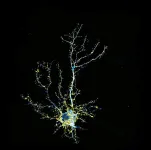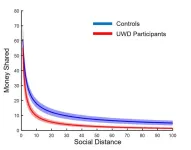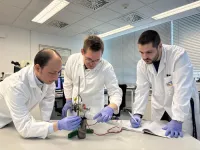(Press-News.org) University of California, Davis researchers have developed a new, neuroplasticity-promoting drug closely related to LSD that harnesses the psychedelic’s therapeutic power with reduced hallucinogenic potential.
The research, published in Proceedings of the National Academy of Sciences, highlights the new drug’s potential as a treatment option for conditions like schizophrenia, where psychedelics are not prescribed for safety reasons. The compound also may be useful for treating other neuropsychiatric and neurodegenerative diseases characterized by synaptic loss and brain atrophy.
To design the drug, dubbed JRT, researchers flipped the position of just two atoms in LSD’s molecular structure. The chemical flip reduced JRT’s hallucinogenic potential while maintaining its neurotherapeutic properties, including its ability to spur neuronal growth and repair damaged neuronal connections that are often observed in the brains of those with neuropsychiatric and neurodegenerative diseases.
“Basically, what we did here is a tire rotation,” said corresponding author David E. Olson, director of the Institute for Psychedelics and Neurotherapeutics and a professor of chemistry, and biochemistry and molecular medicine at UC Davis. “By just transposing two atoms in LSD, we significantly improved JRT’s selectivity profile and reduced its hallucinogenic potential.”
JRT exhibited powerful neuroplastic effects and improved measures in mice relevant to the negative and cognitive symptoms of schizophrenia, without exacerbating behaviors and gene expression associated with psychosis.
“No one really wants to give a hallucinogenic molecule like LSD to a patient with schizophrenia,” said Olson, who is also co-founder and chief innovation officer of Delix Therapeutics, a company that aims to bring neuroplastogens to the market. “The development of JRT emphasizes that we can use psychedelics like LSD as starting points to make better medicines. We may be able to create medications that can be used in patient populations where psychedelic use is precluded.”
Testing JRT’s potential
Olson said that it took his team nearly five years to complete the 12-step synthesis process to produce JRT. The molecule was named after Jeremy R. Tuck, a former graduate student in Olson’s laboratory, who was the first to synthesize it and is a co-first author of the study along with Lee E. Dunlap, another former graduate student in Olson’s laboratory.
Following JRT’s successful synthesis, the researchers conducted a battery of cellular and mouse assays that demonstrated the drug’s neuroplastic effects and improved safety profile relative to LSD.
Key findings included:
JRT and LSD have the exact same molecular weight and overall shape, but distinct pharmacological properties.
JRT is very potent and highly selective for binding to serotonin receptors, specifically 5-HT2A receptors, the activation of which are key to promoting cortical neuron growth.
JRT promoted neuroplasticity, or growth between cellular connections in the brain, leading to a 46% increase in dendritic spine density and an 18% increase in synapse density in the prefrontal cortex.
JRT did not produce hallucinogenic-like behaviors that are typically seen when mice are dosed with LSD.
JRT did not promote gene expression associated with schizophrenia. Such gene expression is typically amplified with LSD use.
JRT produced robust anti-depressant effects, with it being around 100-fold more potent than ketamine, the state-of-the-art fast-acting anti-depressant.
JRT promoted cognitive flexibility, successfully addressing deficits in reversal learning that are associated with schizophrenia.
“JRT has extremely high therapeutic potential. Right now, we are testing it in other disease models, improving its synthesis, and creating new analogues of JRT that might be even better,” Olson said.
A more effective treatment for schizophrenia
Olson emphasized JRT’s potential for treating the negative and cognitive symptoms of schizophrenia, as most current treatments produce limited effects on anhedonia — the inability to feel pleasure — and cognitive function. Clozapine is the one exception, but it has side effects, and is not first-line drug of choice for people severely afflicted with schizophrenia.
Olson and his team are currently testing JRT’s potential against other neurodegenerative and neuropsychiatric diseases.
Additional coauthors include Yara A. Khatib, Cassandra J. Hatzipantelis, Sammy Weiser Novak, Rachel M. Rahn, Alexis R. Davis, Adam Mosswood, Anna M. M. Vernier, Ethan M. Fenton, Isak K. Aarrestad, Robert J. Tombari, Samuel J. Carter, Zachary Deane, Yuning Wang, Arlo Sheridan, Monica A. Gonzalez, Arabo A. Avanes, Noel A. Powell, Milan Chytil, Sharon Engel, James C. Fettinger, Amaya R. Jenkins, William A. Carlezon Jr., Alex S. Nord, Brian D. Kangas, Kurt Rasmussen, Conor Liston and Uri Manor.
The research reported on here was funded by grants from the National Institutes of Health, the UC Davis Provost’s Undergraduate Fellowship, the Camille and Henry Dreyfus Foundation, the Dr. Mohsen Najafi Research Award in Medicinal Chemistry, the Boone Family Foundation, Hope for Depression Research Foundation, the Pritzker Neuropsychiatric Disorders Research Consortium, the L.I.F.E. Foundation, the Chan-Zuckerberg Initiative Imaging Scientist Award, and a National Science Foundation NeuroNex Award.
END
Researchers develop an LSD analogue with potential for treating schizophrenia
2025-04-14
ELSE PRESS RELEASES FROM THIS DATE:
How does our brain regulate generosity?
2025-04-14
Are there areas of the brain, which regulate prosocial, altruistic behaviour? Together with colleagues from the universities in Lausanne, Utrecht and Cape Town, researchers from Heinrich Heine University Düsseldorf (HHU) have studied a very special group of patients and established that the “basolateral amygdala” (part of the limbic system) plays an important role in this. In the scientific journal Proceedings of the National Academy of Sciences (PNAS), they describe that this region calibrates social behaviour.
Prosocial ...
New study reveals wealth inequality’s deep roots in human prehistory
2025-04-14
PULLMAN, Wash. — Wealth inequality began shaping human societies more than 10,000 years ago, long before the rise of ancient empires or the invention of writing.
That’s according to a new study led by Washington State University archaeologist Tim Kohler that challenges traditional views that disparities in wealth emerged suddenly with large civilizations like Egypt or Mesopotamia. The research is part of a special issue of the Proceedings of the National Academy of Sciences, co-edited by Kohler and Amy Bogaard, an archaeologist at Oxford University in England.
Drawing on data from over 47,000 residential ...
New archaeological database reveals links between housing and inequality in ancient world
2025-04-14
If the archaeological record has been correctly interpreted, stone alignments in Tanzania’s Olduvai Gorge are remnants of shelters built 1.7 million years ago by Homo habilis, an extinct species representing one of the earliest branches of humanity’s family tree.
Archaeological evidence that is unambiguously housing dates to more than 20,000 years ago—a time when large swaths of North America, Europe and Asia were covered in ice and humans had only recently begun living in settlements.
Between that time and the dawn of industrialization, the archaeological record is rich not only with evidence of settled life represented by housing, but also with evidence ...
New, non-toxic synthesis method for “miracle material” MXene
2025-04-14
It is one of the most significant trends in materials science: materials that consist of only a single layer of atoms, so-called “2D materials”, often show completely different properties than thicker layers consisting of the same atoms. This field of research began with the Nobel Prize-winning material graphene. Now, research is being conducted into the material class of MXenes (pronounced Maxenes), which consist mainly of titanium and carbon, by TU Wien (Vienna) together with the companies CEST and AC2T.
These MXenes have properties that ...
Cutting-edge optical genome mapping technology shows promise for diagnosis, prognosis, and therapeutic options of multiple myeloma
2025-04-14
Philadelphia, April 14, 2025 – Researchers have demonstrated the potential of the innovative optical genome mapping (OGM) technique for the diagnosis, prognosis, and therapeutic management of multiple myeloma. This new study in The Journal of Molecular Diagnostics, published by Elsevier, details how this novel method can establish the cytogenomic profile of the tumor on a scale suitable for routine practice in cytogenetics laboratories.
Multiple myeloma, a type of blood cancer that forms in plasma cells (a type of white blood cells), is the second ...
Study looks at impact of COVID-19 pandemic on rates of congenital heart disease procedures among children
2025-04-14
Major reallocation of healthcare services during the COVID-19 pandemic meant that elective surgery in children with congenital heart disease (CHD) was significantly reduced, so that those needing urgent, lifesaving and emergency surgery could be treated. However, this prioritisation of the most severely ill children did not increase overall post-operative complications rates or death, a study led by the University of Bristol has shown.
The research, published in Open Heart, suggests that prioritising surgery for younger and more critically ill children may be appropriate when there is a sudden disruption of usual care. The ...
UH researcher unveils new model to evaluate impact of extreme events and natural hazards
2025-04-14
When you’re on a sandy beach or the banks of a river, transformed by rolling waves or slightly still waters, it’s likely you’re not thinking about what happens just beneath the surface, where dirt and pollution are swirling and traveling through to new destinations.
But Hanadi Rifai does. The Moores Professor of Civil and Environmental Engineering and director of the Hurricane Resilience Research Institute, has spent two decades examining Galveston Bay – its tides, currents ...
Illegal poisonings imperil European raptors and could disrupt ecosystem health
2025-04-14
A recent comprehensive assessment on the poisoning of raptors across Europe does not yield good news. This is according to the new paper “Poisoning in Europe Between 1996 and 2016: A Continental Assessment of the Most Affected Species and the Most Used Poisons,” published in the Journal of Raptor Research. A large team of raptor researchers amassed retrospective data on poisoning events across 22 European countries between 1996 and 2016. Carbofuran and aldicarb were the most common toxins reported and disproportionately affected scavenging raptors, especially in Northern ...
UF professor develops AI tool to better assess Parkinson’s disease, other movement disorders
2025-04-14
A University of Florida researcher has developed a groundbreaking open-source computer program that uses artificial intelligence to analyze videos of patients with Parkinson's disease and other movement disorders. The tool, called VisionMD, helps doctors more accurately monitor subtle motor changes, improving patient care and advancing clinical research.
Diego Guarin, Ph.D., an assistant professor of applied physiology and kinesiology in UF’s College of Health and Human Performance, created the software to address the potential risk of inconsistency ...
Computer science professor elected AAAS Fellow
2025-04-14
Dr. Latifur Khan, professor of computer science at The University of Texas at Dallas, has been elected to the 2024 class of American Association for the Advancement of Science (AAAS) fellows.
Khan is one of 471 scientists, engineers and innovators to be recognized across 24 disciplinary sections. The new fellows will be honored at a June 7 event in Washington, D.C.
The AAAS elected Khan in the section on information, computing and communication for “distinguished contributions to the field of machine learning with applications to cybersecurity, social sciences ...






